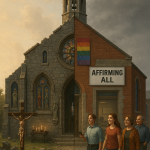Here was the glorious reality of war; the bronzed faces, the worn uniforms; the well-tattered flags, the roll of the heavy guns… while the long line of cavalry, their helmets and accoutrements shining in the morning sun, brought back one’s boyish dreams of joust and tournament, and made the heart beat high with chivalrous enthusiasm.
As a soldier, Myles Walter Keogh consciously imitated his hero. As a soldier-of-fortune, he fought in three different wars, ending his days on a Montana hillside along another colorful figure, George Armstrong Custer. Although it was Custer that Errol Flynn played onscreen, Keogh’s life was in some ways closer to a Flynn movie.
Keogh was born to an affluent family in southern Ireland. As a young man, he attended the Jesuits’ St. Patrick’s College, one of the country’s premier boarding schools. Family lore has him working in a bank before beginning his soldiering. In the summer of 1860, along with some friends, he sailed for Rome to join the Papal Army.
This was the era of Italian unification, when Italy was transitioning from a series of independent kingdoms into a single nation. The Papal States covered much of central Italy, and Pope Pius IX opposed unification, believing that the loss of his political independence would mean the loss of spiritual independence. Hence he issued a worldwide call for Catholic volunteers to defend the Papal throne, known as the See (seat) of Peter.
The Papal Army numbered some 18,000 men from ten different nations. About 1,400 were Irishmen volunteering for what they called “the Last Crusade.” A little over six feet tall, with dark blue eyes and black hair, Keogh was the picture of a soldier. Resplendent in his emerald green uniform, he was commissioned a second lieutenant in the Battalion of St. Patrick in August 1860.
Six weeks later at Spoleto, three hundred Irish volunteers were attacked by an overwhelming number of Italian troops. For bravery in battle, Lieutenant Keogh won the Medaglia di Pro Petri Sede (meaning “for the see of Peter”), which he wore for the rest of his life. But papal troops were forced to retreat to Rome, where the Irish were reorganized as the Company of St. Patrick within the Papal Guard.
Keogh soon became bored with patrol duty, and looked for soldiering opportunities abroad. At this time, it wasn’t unusual for someone to serve in the armies of several nations. He was also disillusioned with church affairs. Some of the phrases that appear in his correspondence include “ignorant, narrow minded Italian Churchman,” “scandalized,” “scoundrels,” and “licentious conduct.” Still, he always considered himself a Catholic.
Archbishop John Hughes of New York was helping recruit Irishmen for the Union Army. Keogh met Hughes in Rome, and resigned his commission early in 1862. Hughes used his influence back home to get Keogh a commission in the Union Army. For three years, the young Irishman served on the staff of several generals, including George B. McClellan, commander of the Union’s principal army, the Army of the Potomac.
A staff officer’s job was to convey the commander’s wishes to subordinates during the course of battle, often dangerous work. Keogh was present at over one hundred engagements, including Antietam and Gettysburg. He ended the war as a brevet (honorary) Lieutenant Colonel. Later he wrote, “I am but satisfied that I have carried out at least some of the rather visionary fancies we as boys indulged of long ago.”
Keogh in his dress uniform as a Seventh Cavalry officer, ca. 1872-1876.
Of the war, Keogh wrote, “I was like in a dream, and completely taken up in war.” At its end, he was commissioned a Captain in the regular army. In the summer of 1866, he was assigned to the Seventh U.S. Cavalry Regiment, where his commanding officer was George Armstrong Custer, a man whose dash and bravery Keogh admired. For the next ten years, Captain Keogh was with the Seventh, where one out of every three soldiers had Irish ancestry.
Frontier service alternated between dull and deadly, with turning to the bottle to ease the loneliness. Keogh himself had a brooding sadness about him. He felt he hadn’t lived up to his own potential. A lifelong bachelor, he was described as moody and emotional, possibly depressive and reportedly a heavy drinker. But he loved the army, and at age thirty-four he declined an inheritance in Ireland that would have made him a propertied gentleman.
In the summer of 1876, the Seventh Cavalry took part in the Great Sioux War to force the Native peoples onto the reservation. Keogh commanded I Troop, and was killed at the Battle of the Little Bighorn on June 25th. Keogh’s body was one of the few not mutilated. This may have had something to do with the religious medal he wore, known as the Agnus Dei (“Lamb of God”). His horse Comanche was the only member of the Seventh to survive the battle, and for years it served as the regimental mascot.
Today it’s impossible to think of war as glamorous, given the last century’s grim, impersonal carnage. But in the 1800’s, the potential for heroism and glory still existed. If there was any dash or verve left in war, it was to be found on the back of a horse. And if any individuals embodied the image of the dashing cavalier, surely among them was Myles Walter Keogh, soldier in three wars, from Rome to the Little Bighorn.











